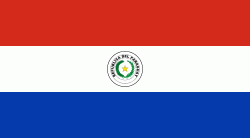Primero de Marzo (Primero De Marzo)
Primero de Marzo (or 1° de Marzo) is a small town and district in the marshy lowlands of the Cordillera Department in Paraguay. The area is located near the shallow meandering river Yhaguy which locals utilize primarily for fishing and recreation. Primero de Marzo's name is derived from the date March 1, 1870, when then Paraguayan President Francisco Solano López was killed by Brazilian troops at Cerro Corá, thereby ending the bloody War of the Triple Alliance.
According to the 2002 National Paraguayan census, Primero de Marzo has a population of 6,019 inhabitants: 3,210 male and 2,809 female. 795 inhabitants live in the urban center of Primero de Marzo while another 5,224 maintain dwellings in the various surrounding rural campos. Some of the larger outlying rural campos include General Diaz, Sargento Cabellero, San Isidro, and Mariscal Estigarribia. Running water and electricity is available to the urban inhabitants, but only some of the rural campos. There are a very few landlines for telephone service in the area. The most reliable being at the Municipality and the Cooperative, Niño Jesus Ltd. Currently, there is limited internet or cellular phone service in the area due to the geography and poor public infrastructure.
According to the 2002 National Paraguayan census, Primero de Marzo has a population of 6,019 inhabitants: 3,210 male and 2,809 female. 795 inhabitants live in the urban center of Primero de Marzo while another 5,224 maintain dwellings in the various surrounding rural campos. Some of the larger outlying rural campos include General Diaz, Sargento Cabellero, San Isidro, and Mariscal Estigarribia. Running water and electricity is available to the urban inhabitants, but only some of the rural campos. There are a very few landlines for telephone service in the area. The most reliable being at the Municipality and the Cooperative, Niño Jesus Ltd. Currently, there is limited internet or cellular phone service in the area due to the geography and poor public infrastructure.
Map - Primero de Marzo (Primero De Marzo)
Map
Country - Paraguay
 |
 |
| Flag of Paraguay | |
Spanish conquistadores arrived in 1524, and in 1537 established the city of Asunción, the first capital of the Governorate of the Río de la Plata. During the 17th century, Paraguay was the center of Jesuit missions, where the native Guaraní people were converted to Christianity and introduced to European culture. After the expulsion of the Jesuits from Spanish territories in 1767, Paraguay increasingly became a peripheral colony, with few urban centers and settlers. Following independence from Spain in the early 19th century, Paraguay was ruled by a series of authoritarian governments characterized by nationalist, isolationist and protectionist policies. This period ended with the disastrous Paraguayan War (1864–70), during which the country lost half its prewar population and around 25–33% of its territory to the Triple Alliance of Argentina, Brazil and Uruguay. In the 20th century, Paraguay faced another major international conflict—the Chaco War (1932–35) against Bolivia—in which it prevailed. Afterwards, the country came under a succession of military dictators, culminating in the 35-year regime of Alfredo Stroessner, which lasted until his overthrow in 1989 by an internal military coup. This marked the beginning of Paraguay's democratic era, which continues to this day.
Currency / Language
| ISO | Currency | Symbol | Significant figures |
|---|---|---|---|
| PYG | Paraguayan guaranà | ₲ | 0 |
| ISO | Language |
|---|---|
| GN | Guarani language |
| ES | Spanish language |















